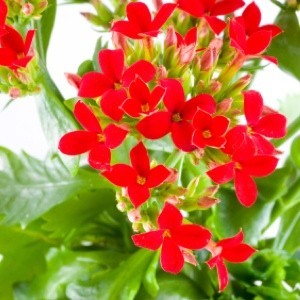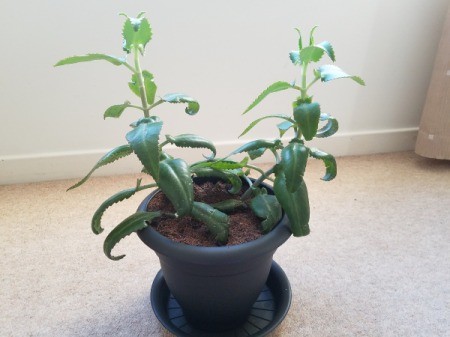 If you are looking for a practical alternative to traditional holiday poinsettias, then flowering kalanchoes may be worth considering. Over the past few years, these happy little succulents have enjoyed a steady gain in popularity as houseplants and Christmas-flowering gift plants, and it's easy to see why. Kalanchoes are easy to care for, come in a variety of festive colors, and offer a long-lasting supply of blooms-from 6 to 8 weeks or longer.
If you are looking for a practical alternative to traditional holiday poinsettias, then flowering kalanchoes may be worth considering. Over the past few years, these happy little succulents have enjoyed a steady gain in popularity as houseplants and Christmas-flowering gift plants, and it's easy to see why. Kalanchoes are easy to care for, come in a variety of festive colors, and offer a long-lasting supply of blooms-from 6 to 8 weeks or longer.
Some types of kalanchoes are grown for their foliage, while others are grown for their flowers. For the purposes of this article, I'm going to be referring only to those types that are grown for their flowers.
Flowering kalanchoes are divided into two basic types: Kalanchoe blossfeldiana and K. manginii hybrids. Of the two, K. blossfeldiana is by far the more popular of the two, and is the type that growers are able to coax into flowering at any time of the year. They come in two sizes: standard (1-1.5 ft high) and miniature (6 inches high), and in a variety of colors including white, yellow, salmon, orange, purple, pink, and red. These compact, bushy plants are easy to distinguish from other holiday plants. Look for plump 2-inch glossy leaves under umbrella-shaped flower heads containing 20-50 tubular blooms.
When received as gifts, kalanchoes are often thrown away after flowering. With the proper care, it is possible to keep them all year long and coax them to flower again.
Similar to poinsettias and Christmas cacti, kalanchoes require shorter days for flowers to develop. Commercial growers fool the plants into flowering by covering them with special shades for 14 hours each day until they form buds. You can accomplish the same thing at home using a simple cardboard box or by placing the plant in a dark closet. Plan to keep the plants in total darkness for 14 hours each day until the flower buds form (about 5-6 weeks), and expect to see flowers about three months after your start this "short day" treatment. For holiday blooms, plan to start a "short day" treatment in early to mid September.
In the spring, when danger of frost has passed, kalachoes can be planted outdoors in your garden in light shade. Plants that become leggy can be cut back to half their size to encourage a more compact form.
Here are the questions asked by community members. Read on to see the answers provided by the ThriftyFun community.
I rescued a kalanchoe (daigremontiana?) that wasn't doing too well. After repotting and giving it plenty of light, it seems to be doing better on top and getting some new baby leaves. However, the bottom leaves are much thicker, stiffer, and most are broken.
Any advice on where to go from here? Should I take off the bottom leaves, or just leave it alone? Any advice would be great! :)
Your plant looks like it is growing well but be sure to not over water and give some sunshine when possible.
I have several beautiful kalanchoe plants in a planter and the lizards have discovered them. At the rate they are eating the leaves the plants will die. I am looking for a solution to the problem. Does anyone know of a way to get rid of the lizards?
I thought lizards ate bugs. Could it be snails?
Sorry, no solutions from me. I live in Manitoba, Canada, and was just wondering where you live that you have lizards eating your plants. That's so cool The only place we have lizards is in the pet shops!
Lizards, unless they are something akin to Iguanas do not eat greenery. They are carnivores, not herbivores. Where do you live, and what do the lizards look like so I may be better able to help you.

(sent in by email)
The leaves of the Kalanchoe are like a cactus - have water in them. I have seen the lizards nibbling on the leaves. I live in a suburb outside New Orleans; it gets very hot and dry for days at a time. Perhaps the lizards are getting water from the leaves. I finally found a flowering plant, the Kalanchoe that handles the sun and heat very well, but now have another problem. Not a big deal!
Mike G
Editor's Note: Maybe it would help to put a little dish of water in or near the plant.
I have a lizard living in my bathroom in my magazine rack under a newspaper. I thought maybe he moved on, but he has not. I dont have a problem with him living there. I noticed there are not any spiders, and little pincher bugs I sometimes see. I thought about getting a large match box and put shredded paper in it for him to live in, and maybe put the box in the magazine rack. I really want to know is, if he will move in it. Debbie
email address is deb1157 AT live.com
I recently noticed that one of my succulent houseplants, a kalanchoe, has powdery mildew on the leaves. I just moved and it is in a new location, but nothing else has changed. How to I treat the leaves? They now have brown spots where I have wiped it off. Thank you for your suggestions.
By R Barbara from Bremerton, WA
I've never treated succulents for powdery mildew, but have other plants using a fungicide purchased at the garden centre. Check your local extension website, or talk to the staff at the nursery to see what they suggest.
Powdery mildew is a disease that affects a wide range of plants, including agronomic crops, fruit, vegetable, and herbaceous and woody ornamentals. It is caused by many different species of fungi. The disease is easy to diagnose as its symptoms are quite distinctive. All powdery mildew fungi require living plant tissue to grow.
lifeandagri.com/
I need tips on getting kalanchoe to bloom? I started a kalanchoe plant from a cutting this past winter. The plant is huge and beautiful, but it has yet to bloom. The last time I started cuttings, I got blooms in a few months after they rooted. Any suggestions?
If you have a fish tank or know anyone who does- use some of the dirty water from routine cleanings. "fish manure" is awesome for those stubborn plants.
My Klanchoe is planted outside and blooms later this fall, every year. I live in Algoma, WI by Lake Michigan. It loves the cold winter and weathers well.
It can be separated in spring and will grow just about anywhere.
I have made many plants out of one.
Hope this helps.
Dorie
The kalanchoe is a thick leafed succulent that is native to Madagascar and tropical Africa. Typically these flowering plants are grown as houseplants, but if you live in an environment similar to their native homeland they can be grown outside. This is a page about, "What is this plant?". (kalanchoe)